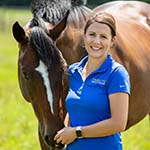The majority of focus on the horse breeding farm is managing the nutrition program of the broodmare band and growing horses; however, it would be imprudent to forget a very important component of the breeding program – the stallion!
The same general approach is taken to managing the nutrition program of a stallion as any other horse. We need to ensure that non-energy nutrients such as vitamins, minerals and amino acids are fed to meet requirements and also provide enough energy to maintain body condition. The requirements of a stallion during horse breeding season are similar to that of a horse in light work. Some stallions remain in work under saddle during the breeding/collection season and this additional work should also be taken into consideration when developing a nutrition program.
Non-Energy Nutrients
Non-energy nutrients play an important role in the health and wellness of the horse but also play some key roles in supporting stallion fertility.
Selenium, for example, supports the integrity of the membrane surrounding sperm. Research has found that low selenium results in low motility and increased incidence of morphological defects.
There are a number of nutrients that act as antioxidants, including Selenium, Vitamin E, Vitamin C, as well as trace minerals such as Copper and Zinc. While they work through different pathways, each of these nutrients play a role in protecting cells from oxidative damage. Recent research points to oxidative damage as a large contributor to reduced fertility as well as poor survival of frozen or chilled semen.
The balance of non-energy nutrients in the diet is critical to ensuring that nutrients are absorbed and utilized effectively. Finding a product that is balanced and complete, instead of combining multiple supplements will ensure that the total diet is balanced and is often a more economical approach as well.
During the breeding and off-season, ensure that at least the minimum recommended feeding level for your stallion’s size is achieved in order to supply non-energy nutrients. A ration balancer should be utilized for easy-keeping stallions in order to keep calorie intake down but supply non-energy nutrients.
Omega-3 Fatty Acids
Omega-3 Fatty Acids are an important component of semen and play a role in supporting sperm motility, which has a direct impact on fertilization rates, as well as sensitivity to cold shock.
Research has shown that supplementing Omega-3 Fatty Acids can be especially helpful for stallions with marginal fertility or for those that produce semen that does not hold up well when cooled or frozen. We find the best results are achieved with our Omega-3 Fatty Acid supplement, Tribute’s Natural Remedy®, when supplementation begins at least 60 days prior to the start of breeding season.
Body Condition Score
Stallions should enter the breeding season at a BCS of 5 to 6 and their energy intake adjusted as needed to maintain condition. Individuals will vary greatly in their energy needs depending on age, level of work as well as general disposition.
The stallion’s activity level will often increase and his attention span for feed will sometimes decrease during the breeding season. This means he needs to receive more calories in a smaller meal, and that meal needs to be highly palatable to encourage him to eat. A well-designed fat supplement added to a sufficient diet, will increase the caloric content of the diet without substantially increasing the volume of feed being fed. Turning the stallion out in a small paddock with grass will also encourage him to eat more and help maintain his body condition.
While many stallions require more energy during the breeding season, it is important to prevent stallions from carrying excess weight as stallion obesity has been linked to decreased libido and can also increase the risk of developing insulin resistance.

